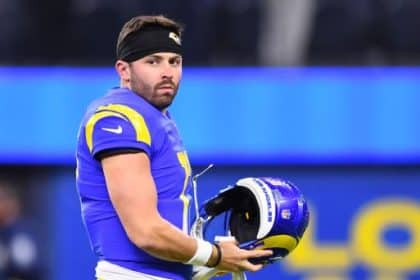In the third edition of our new weekly column, let’s analyze some under-examined elements of this offseason. We’ll look first at an undeniable trend within the free-agent market, then a big-market team’s re-emergence, and another mini-trend that is developing undetected.
Hockey deals come to baseball
Between 2011 and 2013, three superstars — Albert Pujols, Joey Votto and Robinson Canó — signed decade-long deals that lasted through their 40th birthdays. No one else signed such a contract until Trea Turner’s 11-year, $300-million agreement with the Phillies earlier this month. His was quickly followed by two more, by Xander Bogaerts (11 years, $280 million) and Carlos Correa (13 years, $350 million, then 12 years, $315 million.)
Why the sudden rush? Clearly, Bryce Harper’s 13-year deal from four years ago, taking him through age 39, has influenced the industry. In spreading out Harper’s $330 million over 13 years instead of, say, 10, the Phillies reduced their annual luxury-tax liability by nearly $8 million. That made their spending sprees of the last two winters more palatable to ownership. There have been nine contracts in the history of the sport to exceed 10 years; seven of which were agreed to since 2021.
Think of it as more of a tax-avoidance strategy than a strict plan to rely on the player at 40. If $300 million is the price Turner required to sign, it makes far more sense for Philadelphia to pay it out over 11 years than eight.
These tactics aren’t wholly new. National Hockey League franchises have been practicing them for nearly 15 years now, beginning a few years after the league implemented a salary cap. MLB does not have a cap, of course, but plenty of teams treat the luxury-tax thresholds as an unofficial cap.
In fact, there’s a recent baseball example on a much smaller scale. Before the 2018 season, the Dodgers signed Chase Utley to a two-year, $2 million contract, although both parties intended to continue their partnership for only one more season. The second year halved the luxury-tax figure, saving the Dodgers some money.
One interesting question is how far these deals could go. The Athletic once reported that the Phillies first offered Harper the same figure over 15 years, and he negotiated it down to 13. Major League Baseball retains the right to reject deals that obviously circumvent the tax, so there’s a limit here. It’s just not clear exactly what it could be. Shohei Ohtani’s 2023 free agency just might tell us.
The Cubs finally commit to a path
Why, Cubs fans had asked of ownership this winter, spend significant money to lure both Seiya Suzuki and Marcus Stroman a year ago, if they didn’t plan to augment that free-agent duo with more veteran talent?
It was a fair question. It was worth wondering why the Cubs picked last winter to guarantee $156 million to two free agents when pretty much each of the five previous years would have made more sense.
It’s not that either transaction looks terrible. Suzuki missed almost a third of the season, but acquitted himself well when he was on the field. Stroman, too, was hurt some, but he pitched well enough when healthy that he is on track to opt out after the 2023 season.
It’s more that the deals didn’t fit within the current Cubs roster. The point of MLB, obviously, is not to be mediocre. The point is to win. And if you can’t win, or don’t want to spend enough to win, essentially every other team has demonstrated that the next-best strategy is to lose (and save) enough that you can soon win.
Instead, the 2022 Cubs made themselves five or so wins better by signing Suzuki and Stroman. That vaulted them to an, uh, 74-win season. They’ll draft 13th next summer instead of something like eighth or ninth. The $156 million infusion of talent would have been far more impactful to the 2019 or 2020 Cubs, who were a couple players away from seriously, or more seriously, contending. Instead, the Cubs chose to act later.
But they have finally done enough to justify their decision. In recent weeks, they have promised nearly $70 million in 2023 payroll to Cody Bellinger, Jameson Taillon, Drew Smyly and Dansby Swanson, and made long-term commitments of nearly $250 million to the latter two players. Swanson, the shortstop coming off a career year, might push them over the contention edge. They needed to get there sooner rather than later, based on these free-agent pickups.
Suzuki and Swanson will turn 29 in 2023. Stroman has the opt-out clause. Smyly is 33. Taillon is 31 and not throwing as hard as he used to. Bellinger won’t turn 28 until the All-Star break, but it’s been a long time since he was great. A couple more role-playing additions between now and Opening Day would help the Cubs net a return on these investments.
It’s not only the top-tier players getting paid
One of the stories of free agency over the last decade has been the concentration of dollars at the top of the market. Often forced to pick between several similar offers, middle-class veterans have been earning less than they once did.
It’s not attracting the same attention as the multitude of decade-long deals, understandably so, but it’s worth noting that teams are paying lesser players more this winter than has become the norm.
Consider the case of right-handed reliever Trevor May. Two years ago, he became the first notable free agent to sign with the Mets during Steve Cohen’s reign. He had just logged consecutive standout seasons, and for his efforts he earned a two-year, $15.5 million deal.
May was just a free agent again. He struggled with injuries and ineffectiveness in 2022, and yet he will hardly receive a paycut in 2023. Oakland, of all teams, agreed to pay him $7 million for next season. Or consider catcher Omar Narváez, who signed with the Mets for two years and $15 million after an awful 2022 season. Or consider 42-year-old left-hander Rich Hill, who was worse in 2022 than 2021, yet will receive a $3 million raise from Pittsburgh in 2023.
More players are earning more money this winter.
Top stories from FOX Sports:
Pedro Moura is the national baseball writer for FOX Sports. He previously covered the Dodgers for The Athletic, the Angels and Dodgers for the Orange County Register and L.A. Times, and his alma mater, USC, for ESPN Los Angeles. He is the author of “How to Beat a Broken Game.” Follow him on Twitter at @pedromoura.

Get more from Major League Baseball Follow your favorites to get information about games, news and more











